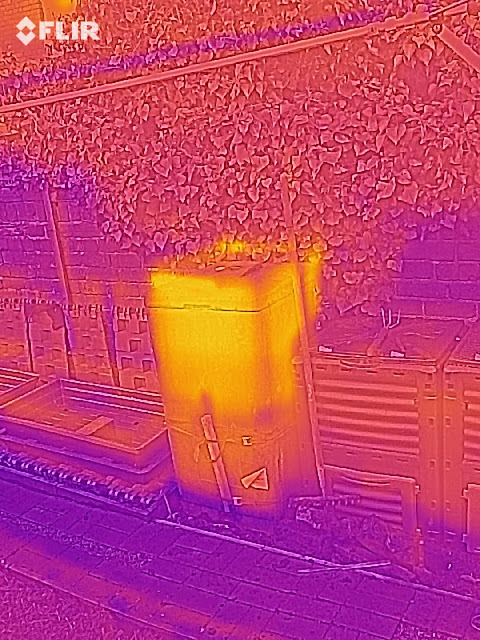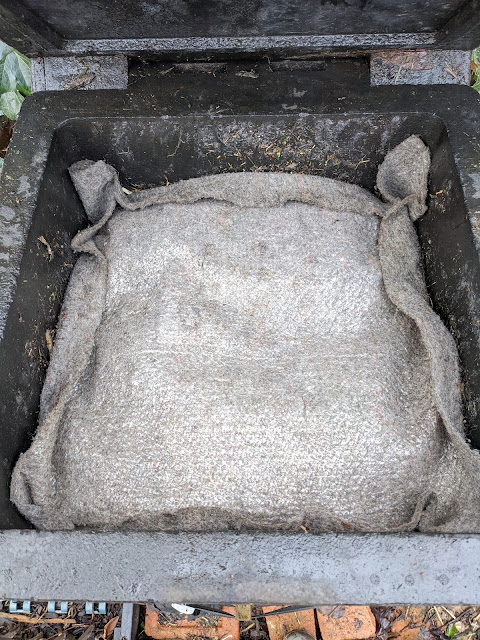In case it wasn't obvious, I am rather keen on composting. I have written some general composting blogs (here and here) as well as some niche ones (here and here). Furthermore, in previous blogs (here, here, here, here, and here), I have extolled the virtues of hot composting (as opposed to the more widely-practised cold composting technique) and described some of the basic principles, ideas, and methods behind hot composting. There will be more articles on this topic, both niche and mainstream.
It is easier to compost during Spring, Summer, and Autumn when the weather is mild/warm and there is a plentiful supply of green waste. With the typical cold composting process, everything grinds to a halt during the Winter - you might add stuff to the compost heap but its origins will still be recognisable when Springtime comes around!
 |
| Photo 1: HOTBIN composter contents (visible) |
 |
| Photo 2: HOTBIN composter contents (infrared) |
Hot composting opens up the possibility of composting all year round. To counteract the colder, even freezing, outdoor temperatures it is essential your hot composter is well insulated and that you can supply a regular source of green (nitrogen-rich) organic waste. The HOTBIN is ideal due to its seamless construction, thick (5 cm) insulating walls, and tight-fitting lid; moreover, the design of the HOTBIN obviates the need to 'turn the heap' and introduce lots of cold winter air.
An infrared photograph of my HOTBIN is shown in Photo 3. The photograph was taken at 10.45 am on the 24th of February 2021 using the FLIR One Pro attached to Moto G(7) Play; it was a sunny day with an outside temperature of 11 ℃ and the HOTBIN was about 80% full (Photo 4). The upper part of the HOTBIN is hotter, because that is where the hottest compost is (Photo 4), and there appears to be some heat leakage between the lid and bin. You can also see the 'hot' steam exiting from the lid vent.
 |
| Photo 3: Infrared Photograph of HOTBIN (24/2/21 @ 10.45 am) |
 |
| Photo 4: Infrared Photograph of HOTBIN contents (24/2/21 @ 10.45 am) |
As noted above, a regular supply of green (nitrogenous) waste is necessary to keep the micro-organisms (e.g. bacteria) in your compost bin multiplying ad infinitum and generating the internal heat that will keep your 'heap' cosily warm. Of course, you still need to add 'browns' to the heap but there is generally no shortage of these during winter. Unless you are still mowing the lawn or pruning evergreen bushes/trees, it is the 'greens' that are likely to be in short supply. Kitchen waste is a good source of 'greens'; however, you may need to be creative in finding other sources if the contents of your kitchen caddy are insufficient or you cannot convince your neighbour to mow his lawn in the middle of winter.
- Animal 'manures' - e.g. chicken, cow, horse - are a great source of nitrogen if you have access to this resource.
- Pelleted chicken manure is a more convenient form of nitrogen (and other nutrients) that can be added as a solid or liquid.
- Urine is free and a good source of nitrogen and other plant nutrients (Footnote #1); it is also rather wet and so should be used sparingly - a wet compost heap does not compost well! Adding some adsorbent material, such as shredded card/paper or crumbled coir block (Photo 6), at the same time should minimise any overwetting issues.
- Urea is a cheap and readily available nitrogen source that can be added sparingly as a solid (if compost is damp) or liquid solution (if compost is dry). You may see it sold as 46-0-0 fertilizer. Unfortunately, fossil fuels are used to produce the ammonia needed for the manufacture of urea, with an estimated carbon footprint of between 0.4 and 1.1 tonne CO2 per tonne of urea produced. If this estimate is correct then scattering 50 g urea prills into your HOTBIN has the same carbon intensity as half a banana (Footnote #2)
- I have not tried general fertilizers such as Blood, Fish & Bone or Growmore. My understanding is that the nitrogen availability is relatively 'fast' even in these slow-release fertilizers. Blood Meal is the high-nitrogen product in Blood, Fish & Bone. I will probably give one of these a try in the future to see whether they work as compost activity boosters.
- Compost Accelerators - predominantly an expensive source of nitrogen. They may also include some beneficial microbes. Use as a last resort.
- Comfrey or Nettle Tea - both contain a good bit of nitrogen though nettle tea is superior in this respect. I always seem to have some left over at the end of the growing season. Add small amounts (100 or 200 ml) neat without dilution.
- Ivy - a good evergreen winter standby that composts well when shredded. We share an ivy hedge (see if you can spot it in Photo 3) with three neighbours and it is a favourite roosting & nesting site for our local house sparrow population. Consequently, I use this resource very sparingly in my compost bins.
 |
| Photo 5: Resident House Sparrows enjoying the Garden Birdfeeder |
Having taken care of the compost bin's dietary needs, it is now time to consider some physical methods for maintaining or upping the temperature of the active composting part of the bin to >50 ℃. I do this in two ways:
- Add hot water bottles: The original Kick Start Bottle that came with my HOTBIN is no more - I cannot remember whether it developed a leak or the cap broke. In any case, I re-purposed a couple of 2.5 litre bottles that once held organic patio cleaner. I add about 1.8 litres of boiling water (a kettle-full) to each bottle and bury it in the compost pile (Photo 6). I save a bit of time and energy by filling the kettle from the hot water tap. It takes 0.12 kWh of electricity, with a carbon footprint of about 40 g CO2e, to raise 3.6 litres of water from the hot tap (45 ℃) to boiling point. I, typically, use two bottles to provide a bigger kick start to the composting process providing about 450 kJ of energy to the compost pile.
 |
| Photo 6: Winter HOTBIN with hot water bottles |
At 40 ℃ and above, bacteria in the compost become superactive and will rapidly multiply provided they have access to a usuable nitrogen source. Heat is a by-product of this growth. The HWBs are creating warm spots in the otherwise 'cold' heap where the bacteria multiply and generate more heat which spreads to other parts of the heap enabling even more bacterial growth generating even more heat ...
The HWB technique can also be used to get a new compost heap off to a rapid start.
- Cover the top of the Heap with a Mat: We saw in Photo 3 that most of the heat leakage is around the lid of the HOTBIN. Heat loss through the vent in the lid is necessary for the HOTBIN hot composting process to work. Heat loss around the edges of the lid should, however, be minimised. First of all, check the contact surfaces of the lid and base are free of detritus as this will stop the lid closing fully. Then consider adding a breathable mat to insulate the top of the compost pile and reduce heat loss.
 |
| Photo 7: Breathable Insulating Mat |
There are a number of reasons why you should consider using a top mat in the HOTBIN which I discuss here. In winter, its most important property is to insulate the top of the pile to reduce heat losses by convection, especially when the HOTBIN is only partially full. There is little point heating the space above the pile where there isn't any composting to be done. It is important the mat is breathable and not tight-fitting so that the chimney effect, on which the HOTBIN relies, continues to work. For this reason I use a piece of thick capillary matting.
Footnote #1: Urine is a dilute solution of urea plus lots of other chemicals and micro-organisms. It can be used as a fertilizer (see here, here, and here) as well as a number of other uses. In terms of its key fertilizer properties, as-received urine has an NPK value of 0.7-0.15-0.22. It is the relatively high nitrogen content (about 1 %) that makes it a useful compost accelerator when used sparingly - the 95% water content is a bit of a disadvantage so include dry/adsorbent material when using!
Footnote #2: I must admit I was a little sceptical of this estimated value (0.4 - 1.1 tonne CO2 per tonne of urea) for the carbon intensity of urea production - it seemed on the low side so I had to wonder whether they had considered all the possible inputs. Quantifying the carbon footprint of a complex chemical process is not a trivial task so I decided to try another information source - How Bad Are Bananas? by Mike Berners-Lee. This reference estimated a carbon intensity of between 1 and 4 tonnes CO2e for each tonne of nitrogen fertilizer (ammonium nitrate) produced depending on the efficiency of the process. So it seems a value of 1 tonne CO2 per tonne of urea is not unreasonable for the carbon footprint. Hopefully, this carbon intensity will reduce in the future through more efficient processes leading ultimately to green urea production.






0 comments:
Post a Comment